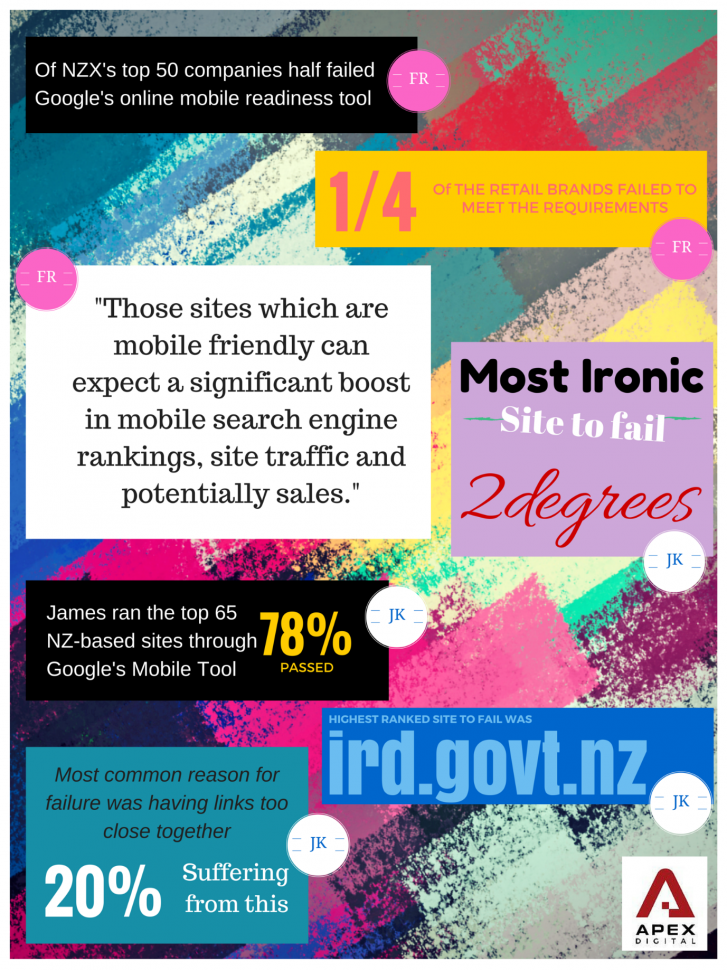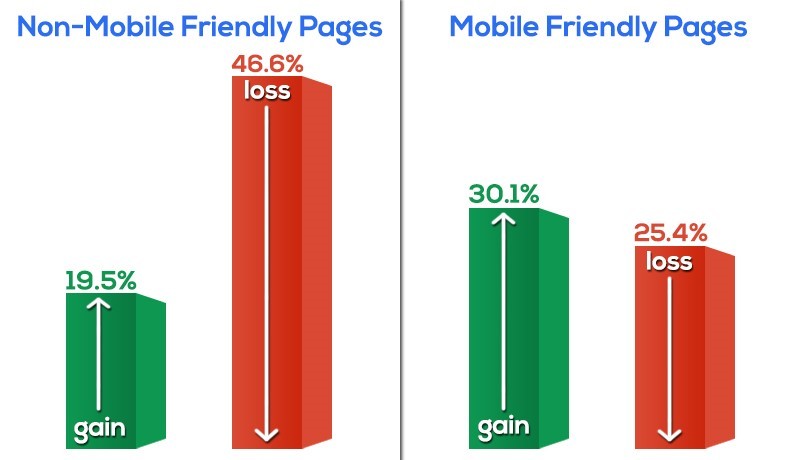We aim to respond to all messages within 1 business day. You'll be hearing from us soon!
In the meantime, perhaps you'd like to learn more...
Mobilegeddon: The Case for Mobile-Friendly Websites
If you haven’t heard about Google’s April 21st rollout, it’s time to pull your head out of the sand or book, take a step away from the computer screen, or simply just come up for air. The 21st April rollout was so important, that it was even labelled and the term Mobilegeddon coined. With a name like this, you can only envisage a complete natural disaster with everlasting consequences!
Being identified as approaching since February 2015, there has been a proliferation of coverage, numerous articles written and in some quarters, significant scaremongering amongst the SEO and business worlds.
In effect, it had been noted that this is the biggest algorithm change in Google’s history, that would surpass the effects of the Panda and Penguin updates – Google sure does love its ‘P’ mammal updates. And who is in the firing line?
Evidently all businesses, but the ones that it will affect predominantly, are those SMEs (Small to Medium Enterprises) that haven’t had the opportunity, financial resources, or technical nous to ensure that their website is mobile-friendly (if they even have a current website).
Before digging deeper, let’s take a step back. Why does Google always change its algorithm?
At the forefront of every alteration to its algorithm is the notion of providing a better experience for its users. Google wants to ensure that whatever search results a user receives, it is the most accurate, of the highest quality and is fast. Remember, Google is also a business – if the service it provides is not what the customer wants, the customer goes elsewhere.
If you take an even more pessimistic view, the rollout is discussed in some quarters as a revenue gathering exercise which, through scaremongering, is generating a hysteria with business owners flocking to their web development companies to align their sites to mobile-friendly status. Robert Hof, provides a not so positive view of the algorithm in an article Why Google’s Mobilegeddon Isn’t The End Of The World For Most Websites, and there does seem to be an element of potential reliability hidden amongst his contribution. With some of the data that has come out recently though, his opinion may soften a little.
So Mobilegeddon, what exactly is it?
Okay, we’ve changed tack a little, so what was/is Mobilegeddon? As previously mentioned Google is always looking to provide the best search results for users that it possibly can.
The importance of the Mobilegeddon update is that these changes only impact mobile results, and with sources indicating that 60 percent of all Google searches are now carried out on mobile devices, it is understandable that Google has rolled out an update specific to mobile.
We should also note that it was deemed important in the landscape by Google as it was actually alluded to in advance of it being implemented! If you’ve been in the SEO world for any period of time, the first time you are usually aware of an update is when it actually starts impacting your results. In the eyes of Google, this update must have been seen as significant – it was first mentioned to the outside world in February 2015 – two months before it was due to be rolled out. This and the nature of the comments made prelaunch is why there has been a ripple effect throughout the industry and a huge element of anticipation as to what the final outcome will look like.
Though the world only got wind of a mobile-friendly update in February, it is likely that this has been in the works for some time. In an earlier blog for our sister company, Limelight Online, I noted the emergence of Google’s labelling of sites as mobile-friendly, a move that began on 18 November 2014[1].
Marcus Tober of Searchmetrics identified some key changes from Google in regards to focusing on mobile results, even before the labelling of mobile-friendly search results by Google in November 2014. He notes two more significant junctions[2]:
- 06/2013: Google devalues pages with faulty (mobile) redirects and smartphone-only errors
- 07/2014: Google marks pages in the SERPs that use mobile-unfriendly technologies, which may not work on smartphones, such as Flash.
One important thing to note is that Mobilegeddon is not a site-wide focus, but rather a page level update, where individual pages and their mobile-friendliness are noted.
Is being seen on Mobile Search results important?
Okay, so it’s been on the cards for a while, but is it really all that important? We strongly believe that being seen in mobile search results will become very significant with mobile device usage on the increase and searches becoming more prevalent.
Adam Bunn, SEO Director of digital marketing agency Greenlight, highlights the importance of ranking in the top spot on mobile. With the top spot attracting 20-30% of page clicks, position 2-3 achieving 5-10%, and position 4 and below around 1%[3]; not being mobile-friendly could see a large decrease in the visibility of your business in mobile search results and ultimately in the eyes of potential customers.
When put into the context of other previous Google algorithm changes, this change also has the ability to significantly impact the viability of many businesses – a change to the search algorithm in Feb 2011 (unrelated to mobile-friendliness; focusing on promoting high quality content – dubbed ‘Panda’) caused many businesses to head into financial ruin.
It is more likely that the impact will vary business to business and be closely aligned to the market and location that you’re operating within. For those businesses that are location dependent, for example cafés, restaurants, bars and shops, the Mobilegeddon update could have a significant impact upon your visibility to your clientele. If you were once ranking in position 1 or 2 as a café in a specific location, and fall to position 4 or 5, your site’s traffic (and potential bottom line) could be severely impacted.[4]
That said, having a non-mobile friendly site may not be the business-killer that the scaremongering leading up to the change suggested. The impact of Mobilegeddon may be limited if:
- Most of your organic search traffic comes from desktop devices (but be wary if your competitors are mobile-friendly!)
- Your competitors aren’t mobile-friendly. Everyone is now on the same level playing field, so the opportunity exists to improve your rankings and it is only a matter of time before a competitor sees the same opportunity.
Google, through Lisa Bora – head of Mobile, Google Australia / New Zealand, did provide some additional commentary in the lead-up to the algorithm change with the notion of soothing the panic that was beginning to fester.
"There have been a few misconceptions flying around about this change, so we wanted to clear them up.
- Firstly, mobile-friendliness is just one of 200 signals that we use to determine the ranking of results.
- Sites that aren’t as mobile-friendly as they could be won’t disappear. In fact, they may still rank highly if they contain great content that people really want.
- And again, just to be really clear, this is just for mobile results.
Why are we making this change? Well, we’ve all experienced bad mobile sites. Miniscule font, links that require Tinkerbell’s tiny fingers to click, or a sideways scroll that last for ever and ever and ever and ever. Which is a real problem, because mobiles are increasingly how we access the internet. The vast majority of Kiwis now have smartphones, and we use them daily.
Bad sites are bad for business too: visitors abandon websites that aren’t mobile friendly at higher rates. Research shows[5] 74% of people say they are more likely to return to a mobile-friendly site”. [6]
So what was the impact of Mobilegeddon?
In New Zealand, examples of the Mobilegeddon impact are hard to come by but are no less important.
Though it is difficult to notice if there was any impact that occurred on a local level, we did personally note that the Apex Digital site on mobile search is ranking number one for the ‘website development new plymouth’ search query within the week of the rollout. It is the first time we have seen this result and we can only assume that due to the responsive nature of the Apex Digital site and our ongoing digital marketing activities that this result could be aligned to the Mobilegeddon phenomenon.
Two people who have commented within the New Zealand landscape are Fleur Revell and James Kemp.
“With over two thirds of adult New Zealanders owning a smartphone and around 50% of search engine queries originating from mobile phones, it’s not surprising Google has altered its algorithm to make mobile searches more user friendly," she says.[7][8]
Fleur Revell, Impact PR
“For anybody who depends on conversion or interaction through their site, not having a mobile strategy will rapidly start to hurt. The proportion of people accessing the web only through a mobile device is growing. Not being there, testing, innovating and communicating means you are essentially invisible to a whole segment of the market.”[9].
James Kemp, Stop Press NZ
Most data related to the Mobilegeddon rollout focused on the situation prior to the rollout and centred on whether or not NZ businesses were ready for the rollout of the update.
A summary of their findings included:
 When we look further abroad for data around the impact of Mobilegeddon, there are a few resources that have undertaken some preliminary studies.
When we look further abroad for data around the impact of Mobilegeddon, there are a few resources that have undertaken some preliminary studies.
Four days after the algorithm took effect, Searchmetrics identified a preliminary list of the 50 Winners and 50 Losers. You can access the full list here.[10] From this analysis they determined that there were some significant changes in Mobile SEO visibility following the rollout of Mobilegeddon. With these changes not affecting the business’ desktop search results they concluded that it is significantly likely that the impact was the result of the mobile-friendly algorithm roll out.[11]
Glenn Gabe of G-Squared Interactive is another individual who carried out some original reviews of the impact of Mobilegeddon. Much like Searchmetrics, he noted a shift in mobile rankings but was unable to provide any further insight into why the impact took place except for the roll out.
For more information on Gabe’s analysis and findings, refer to his article Now We Have Liftoff: The First Examples of Google’s Mobile Friendly Algorithm In Action.
One party that does provide some good analysis and potentially a black and white answer on whether Mobilegeddon was as big as first thought was that of Stone Temple Consulting (STC). In their article, Mobilegeddon: Nearly 50% of Non-Mobile Friendly URLs Dropped in Rank they analysed data prior to the rollout and then post rollout to determine if an effect has indeed taken place, and at a level that the industry thought would occur.
A rough summary follows[12]:
After pulling ranking data on the top 10 results for 15,235 search queries the week of April 17th (before the algorithm rollout), and again the week of May 18th, the data was analysed. The data also included whether or not the URLs in the results were designated as mobile friendly by Google or not.
What they found was:
- The non-mobile friendly URLs were impacted significantly- almost 50% dropped in rankings, and 2.3 times as many dropped as those that increased.
- The mobile friendly pages fared much better, with an overall increase in rankings.
- With this in mind, it seems that the update did in fact support a preference for mobile-friendly sites.

Part Two of STC’s analysis looked into determining what happened to the top 10 sites and the make-up of those sites – i.e. non-mobile friendly URLs v. mobile friendly URLs, and whether the percentage of the mobile friendly had increased.
The results were:
- On April 17th, we had 56,164 Non-Mobile Friendly URLs (36.9%), and as of our May 18th measurement, that dropped to 54,162 URLs (35.6%).
- On April 17th, we had 96,186 Mobile Friendly URLs (63.1%), and by May 18th that had increased to 98,188 URLs (64.6%).
- This accounted for a small net shift of a 1.3% increase of Mobile Friendly URLs in the top 10 results – nowhere near the impact of what Panda or Penguin affected.
So what was it then? Was there an impact or not? These results seem somewhat conflicting, but STC hypothesise that were a number of factors at play here, not just the algorithm release. They also note that during the month of review, there were likely to be other factors including the Search Quality update, other algorithm tweaks within the month and the general churn that takes place in Google’s search results.
CRYSTAL BALL GAZINg
It is safe to say that mobile friendliness will be something that continues to grow from strength to strength. It is only one of many ranking signals and will continue to be of importance, but not at the expense of good quality content.
While the impact of the rollout has been limited to mobile search only, it stands to reason that in the long term and indirectly, desktop rankings will likely be affected. Joost de Valk states Google is known to use click through rate (CTR) from the search results as a ranking factor, which he predicts would be impacted by this change. With over 50% of searches happening on mobile (depending upon the research used) it’s a major search medium. And with backlinks and URLs only shared by visitors once they’ve navigated to your site, this ties back to rankings and therefore may impact on desktop search in the long run.[13]
WHERE TO NEXT
If you’ve managed to make your site mobile friendly, congratulations – you’re most of the way there! If not, the simple thing is to talk to some experts and get busy making your site mobile-friendly as quickly as possible.
In the second part of this series, I’ll take a closer look at the things you can do to optimise your ‘mobile’ site and uncover some of the main things that help with mobile friendliness – keep an eye out for this next month. As a lead in, you should be thinking about your user and their experience they have when they interact with your website – whether that is via mobile, tablet or desktop. It’s all about usability – the core or foundations on which Mobilegeddon was founded on in the first place.[14]
Not sure whether your site is mobile-friendly? Be sure to check out an earlier article from one of our Directors, Karyn, who takes a summative look into Mobilegeddon, tools for testing your site’s mobile-friendliness, and some additional resources on the topic; Important Google Mobile-Friendly Update Coming.
The good news for businesses without mobile-friendly sites is that the industry has noted that Google is actually reprocessing new mobile-friendly pages quite quickly. Moz noted that once they had redesigned their blog to be mobile-friendly, their result was already showing the mobile-friendly tag within 24 hours.
With the update now being rolled out for over four months, if your site isn’t mobile-friendly, it’s likely that you would have seen a drop in your search results via mobile devices – assuming you were ranking in the first place. Remember, to rank you still need to be doing everything you can from an SEO point of view – you cannot solely rely on the fact that your site is mobile friendly shooting you to the top of the rankings.
Summary
Mobilegeddon was an algorithmic update. The impact in the short-term only affects those searching on mobile devices and it gives a visibility boost to mobile-friendly pages in Google’s mobile search results only.[15] The result is that mobile searchers will find it “easier to get relevant, high quality search results that are optimized for their devices.”[16]
Mobile-friendly sites are only one signal when it comes to ranking – at the foundations you still need to ensure that your site is relevant and useful. You won’t see a spike in ranking solely based on your site being mobile-friendly.
Results after four months are pointing to a bigger impact than what was first thought, and with Google, it is likely to be a first step in a range of ‘tweaks’ to their algorithm that will continue to be applied into the future. What’s certain is that we’ll continue to see the importance of mobile-friendly sites grow and they’ll have a significant advantage over non-mobile-friendly sites. [17]
“Once they have tuned it (the algorithm), and gain confidence on how the algo works on the entire web as a data set, they can turn up the volume and make the impact significantly higher.”
Eric Enge, 2015[18]
On a business level, the importance of the Mobilegeddon update will solely rely on the importance of search results for your particular brand, product or services. Some business’ reliance on search is minimal and in those instances the impact of Mobilegeddon isn’t likely to be significant in the short term, but it’s important to understand that as your competitors move to mobile-friendly websites, their sites will leap-frog yours in the future, if they haven’t done so already.
It’s fair to say that this update has had a significant impact and will continue to do so. If your site isn’t mobile-friendly yet, now might be time to give us a call and discuss how we can help you take advantage of better visibility in Google’s mobile search results. Hit by Google's algorithm update? We'd also love to hear your story in a comment below.
Resources[1] http://venturebeat.com/2015/04/20/googles-mobilegeddon-everything-you-need-to-know/
[2] http://blog.searchmetrics.com/us/2015/04/16/google-mobile-update-everything-you-need-to-know/
[3] http://money.cnn.com/2015/04/21/technology/google-mobilegeddon/
[4] https://yoast.com/mobilegeddon-has-come/
[5] http://searchenginewatch.com/sew/study/2208496/72-of-consumers-want-mobilefriendly-sites-google-research
[6] http://google-newzealand.blogspot.co.nz/2015/04/mobilegeddon-were-going-for-mobiletopia.html
[7] http://www.computerworld.co.nz/article/572956/why-kiwi-businesses-unprepared-mobilegeddon/
[8] http://bizedge.co.nz/story/mobilegeddon-kiwi-businesses-go-flames/427ce82a-aa75-11e4-aa3b-0abdbf634b7d/
[9] http://stoppress.co.nz/blog/2015/04/mobilegeddon-nz-good-bad-and-ugly
[10] http://blog.searchmetrics.com/us/2015/04/25/google-mobile-update-mobilegeddon-winners-and-losers-us/
[11] http://blog.searchmetrics.com/us/2015/04/25/google-mobile-update-mobilegeddon-winners-and-losers-us/
[12] https://www.stonetemple.com/mobilegeddon-may-have-been-bigger-than-we-thought/
[13] https://yoast.com/mobilegeddon-has-come/
[14] https://yoast.com/mobile-friendly-sites-seo/
[15] http://searchengineland.com/tomorrow-is-mobilegeddon-are-you-ready-for-the-google-mobile-friendly-update-219291
[16] http://fortune.com/2015/04/21/google-mobilegeddon/
[17] https://moz.com/blog/day-after-mobilegeddon
[18] https://www.stonetemple.com/mobilegeddon-may-have-been-bigger-than-we-thought/
Related posts
Add a comment2 Comments
AWESOME! LET'S GET STARTED
TELL US HOW WE CAN HELP
We aim to respond to all messages within 1 business day. You'll be hearing from us soon!
In the meantime, perhaps you'd like to learn more...





